Posted by: Northwest Eye in General on August 26, 2025
Overview
Mucous membrane pemphigoid (MMP) is a rare autoimmune disorder that can be quite distressing, characterized by blistering of mucous membranes. It particularly affects sensitive areas such as the eyes, mouth, and genitals. If not diagnosed and treated early, MMP can lead to severe complications, which can understandably cause anxiety for those affected.
We understand that recognizing the symptoms early is crucial. This article emphasizes the importance of a multidisciplinary approach to care, which can provide reassurance and support. There are various treatment options available, including corticosteroids and immunosuppressive agents, that can effectively manage the condition and improve patient outcomes.
It’s common to feel overwhelmed, but you are not alone in this journey. Seeking help and understanding the available options can make a significant difference in your experience. We are here to help you through this process, ensuring you receive the compassionate care you deserve.
Introduction
Mucous membrane pemphigoid (MMP) is a rare yet impactful autoimmune disorder that primarily affects the delicate mucous membranes of the body. This condition can lead to painful blisters and potential complications, which understandably causes concern for those affected and their families. Understanding MMP is vital; early diagnosis and effective management can significantly improve quality of life.
We recognize that the complexities surrounding its causes, symptoms, and treatment options can leave patients feeling overwhelmed. It’s common to feel uncertain about navigating this challenging landscape. What strategies can be employed to ensure optimal care for those living with MMP? Together, we can explore ways to address these concerns and foster a supportive path forward.
Define Mucous Membrane Pemphigoid: Overview and Significance
Mucous membrane pemphigoid (MMP) is a rare autoimmune blistering disorder that primarily impacts mucous membranes, such as those found in the eyes, mouth, and genitals. We understand that facing such a condition can be daunting. Mucous membrane pemphigoid is characterized by the formation of blisters and erosions, leading to significant discomfort and serious complications.
It’s crucial to recognize the severe ocular risks associated with mucous membrane pemphigoid, which include scarring and potential vision loss if not managed effectively. Recent studies highlight the importance of early diagnosis and intervention for mucous membrane pemphigoid, as this autoimmune condition is often underrecognized due to its rarity. This emphasizes the need for increased awareness and education among patients and healthcare providers alike.
Real-world management of MMP involves a multidisciplinary approach. It often requires collaboration among specialists to ensure comprehensive care. We know that navigating treatment options can be overwhelming, which is why play a vital role in providing resources and support. They help individuals connect with others facing similar challenges, fostering a sense of community.
By deepening our understanding of mucous membrane pemphigoid, we can enhance patient outcomes and improve the quality of life for those affected by this complex issue. Remember, we are here to help you through this process.
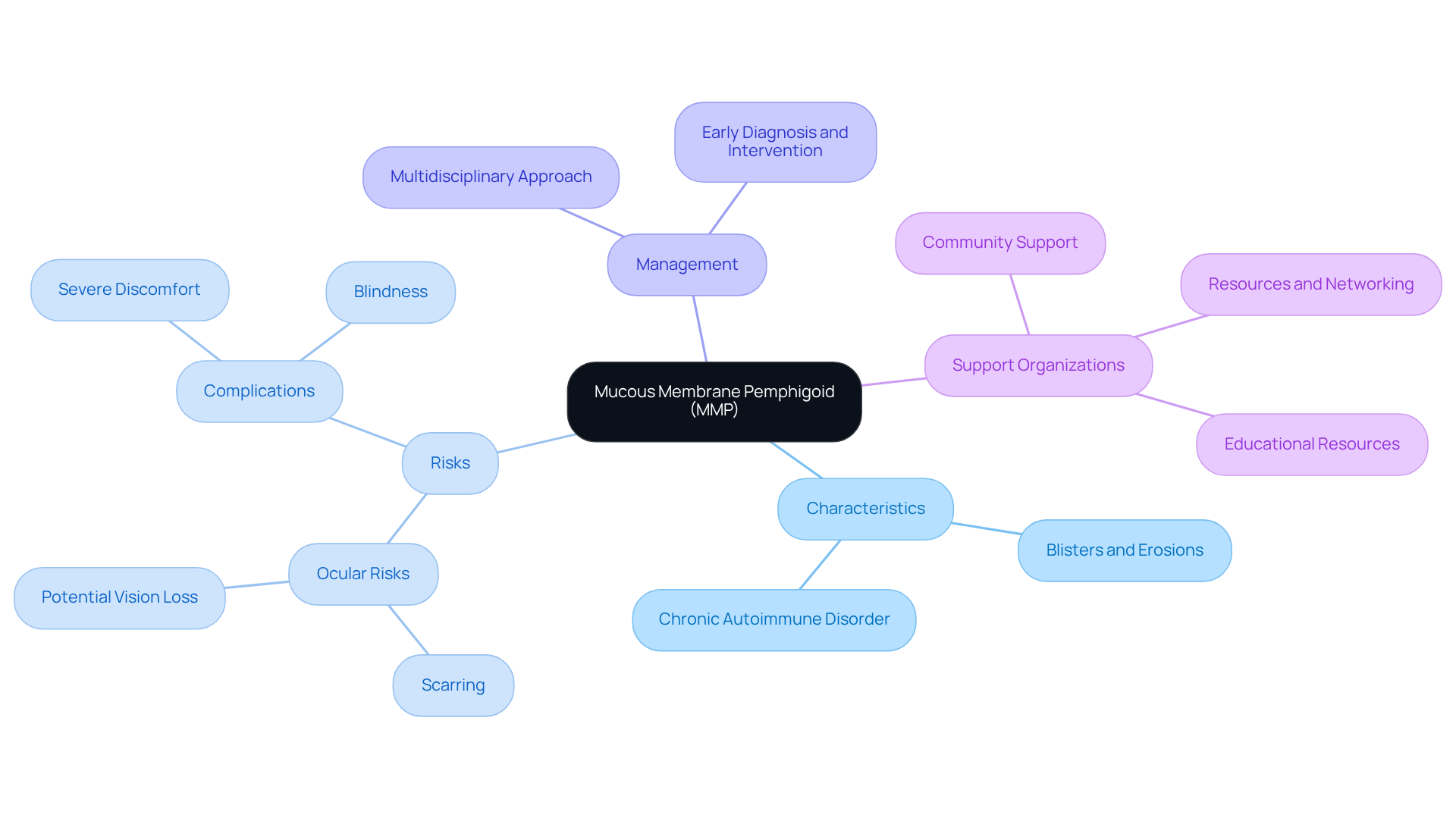
Identify Causes and Risk Factors of Mucous Membrane Pemphigoid
Mucous membrane pemphigoid (MMP) is a condition that can be concerning because it involves the immune system mistakenly attacking the proteins that anchor mucous membranes to the underlying tissues. This disorder primarily affects older individuals, with a peak occurrence around the age of 70. We understand that this may raise questions, especially since MMP is observed to be approximately compared to men.
It’s important to know that individuals with a history of other immune system disorders may face an increased risk. This suggests a possible connection between various immune-related conditions, which can understandably be worrisome. Additionally, genetic factors might also come into play; having a family history of immune system disorders can heighten vulnerability.
Recent research highlights that environmental influences, such as exposure to certain medications or infections, may further exacerbate the risk of developing mucous membrane pemphigoid (MMP). Notably, studies show that 25% of older persons in the US had thyroid autoantibodies, which could be relevant when discussing the risk factors associated with autoimmune diseases, including mucous membrane pemphigoid (MMP). Understanding these risk factors is crucial for early diagnosis and effective management of the disease.
We are here to help you through this process, ensuring that you have the support and information you need.
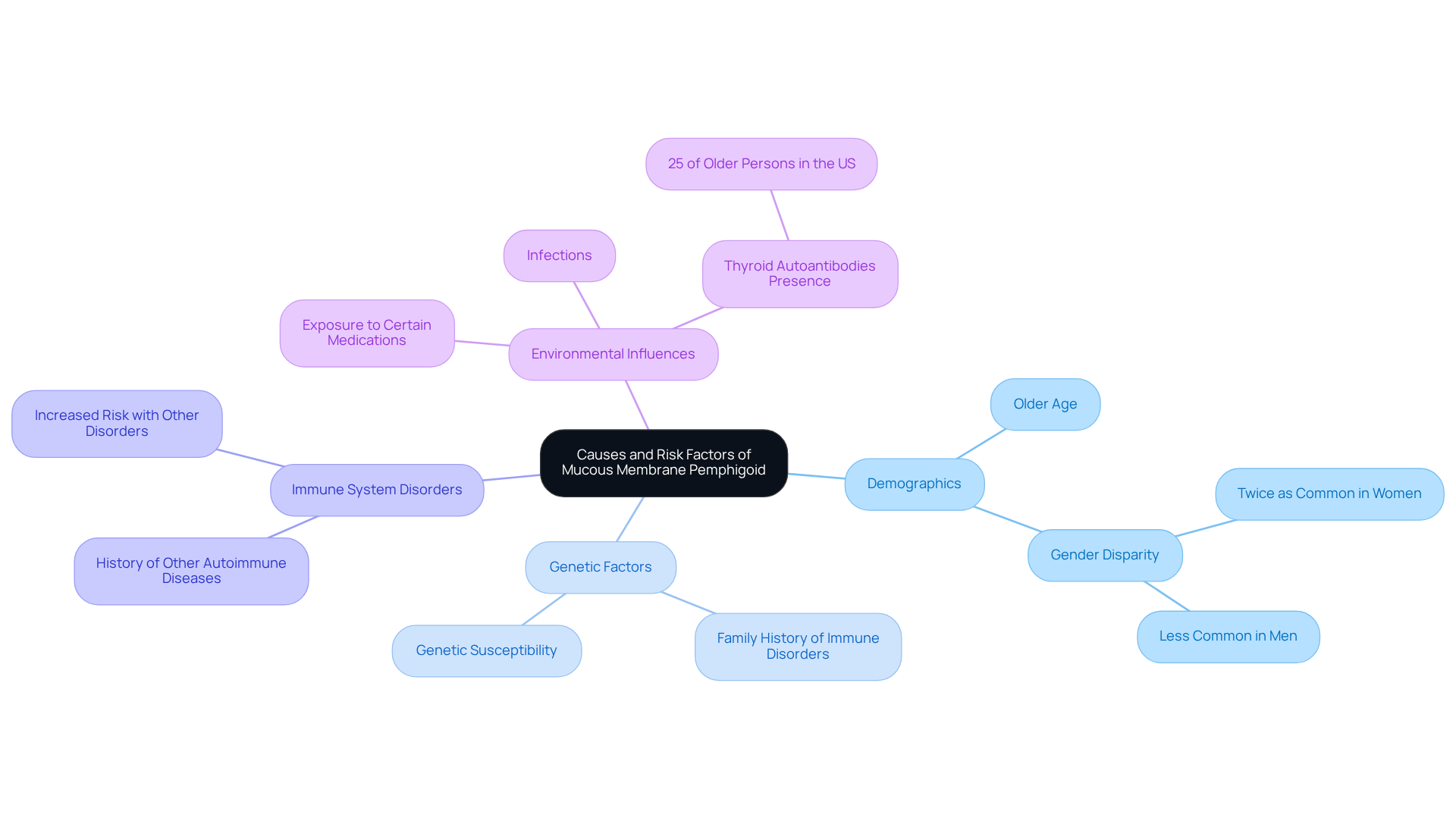
Recognize Symptoms and Clinical Features of Mucous Membrane Pemphigoid
Symptoms of mucous membrane pemphigoid can manifest in various ways, primarily affecting mucous membranes, especially in the mouth and eyes. We understand that patients often report painful blisters and erosions, leading to significant discomfort. Ocular symptoms may include redness, irritation, and discharge, which can potentially result in vision problems, such as blurred vision, if not addressed promptly.
In addition to these ocular manifestations, individuals may experience difficulty swallowing, oral pain, and lesions in the genital area. Recognizing these symptoms early is vital, as they can progress to complications like scarring and loss of function in the affected areas. For instance, some patients may develop entropion or trichiasis, where the eyelids turn inward, causing further irritation and increasing the risk of blindness. It’s common to feel overwhelmed by blurred vision that may develop from underlying issues related to mucous membrane pemphigoid, making awareness of these clinical characteristics crucial for prompt intervention and management.
As Heather, a mother of a child with MMP, expressed, ‘I think that’s what kept me going—waking up every day and finding ways to make her smile.’ This highlights the emotional journey families experience while navigating this situation. We are here to help you through this process, providing every step of the way.
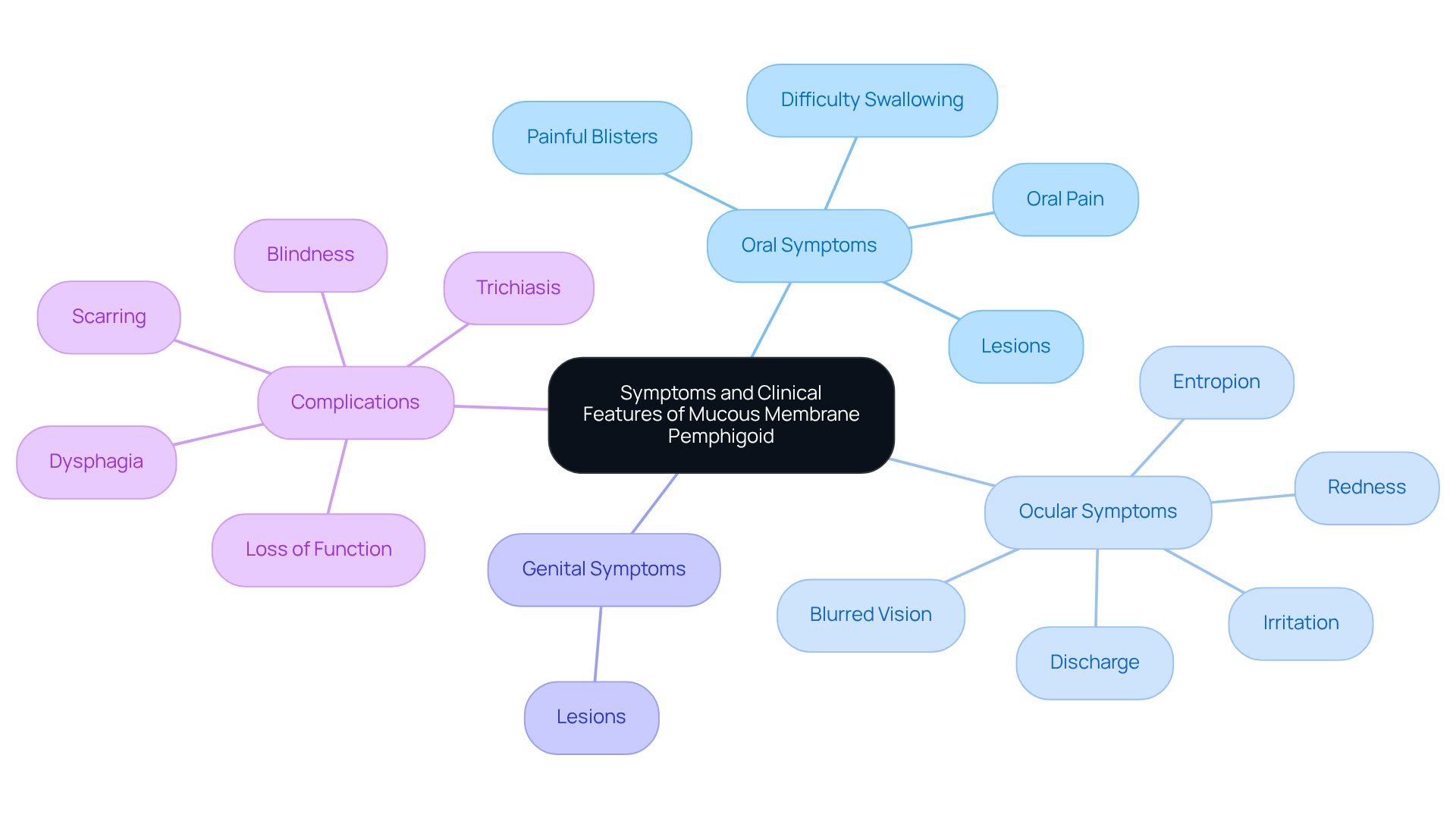
Explore Diagnostic Approaches for Mucous Membrane Pemphigoid
Diagnosing mucous membrane pemphigoid (MMP) necessitates a multifaceted approach that integrates clinical evaluation with laboratory testing. We understand that facing such a diagnosis can be overwhelming, and a , alongside a detailed patient history, is crucial for accurate diagnosis. For instance, an 80-year-old female patient presented with extensive oral mucosal lesions and skin lesions, suggesting a possible diagnosis of mucous membrane pemphigoid, highlighting the importance of thorough clinical assessment.
Dermatopathological analysis of biopsy samples plays a pivotal role in this process. It can confirm the presence of antibodies targeting the basement membrane, which is characteristic of mucous membrane pemphigoid. Direct immunofluorescence tests are also employed to identify specific antibodies within the tissue, revealing linear basement membrane zone deposition of IgG, which further supports the diagnosis.
Successful cooperation between dermatologists and ophthalmologists is crucial. This collaboration ensures a comprehensive evaluation that tackles the intricacies of this condition. As Weijun Liu observed, both the diagnosis and management of mucous membrane pemphigoid (MMP) are challenging, highlighting the necessity for a collaborative approach. We are here to help you through this process, as this collaboration not only enhances diagnostic accuracy but also facilitates timely and appropriate management of mucous membrane pemphigoid.
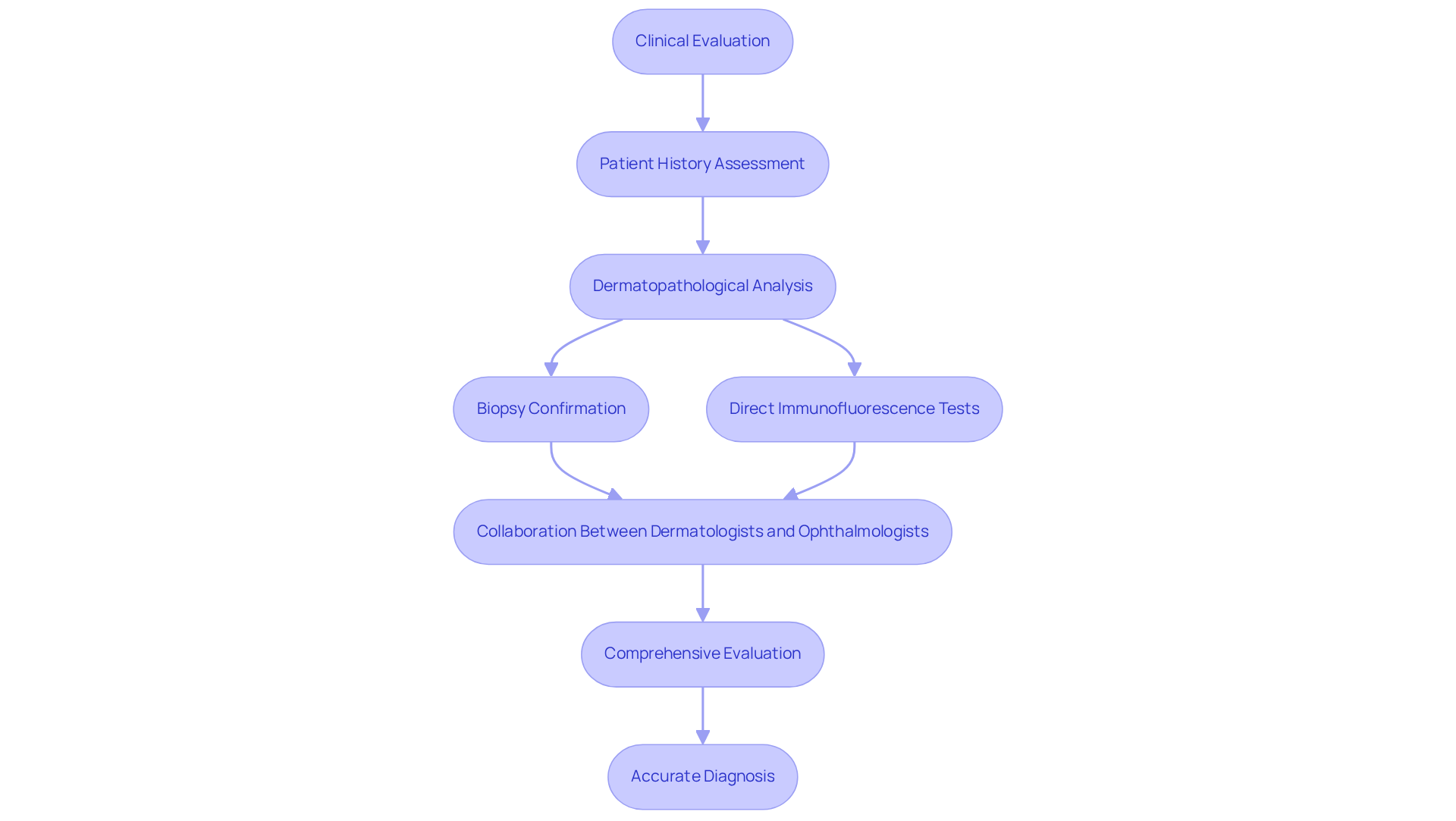
Review Treatment Options and Management Strategies for Mucous Membrane Pemphigoid
Managing mucous membrane pemphigoid involves alleviating your symptoms and preventing complications. We understand that dealing with this condition can be challenging. Corticosteroids are often prescribed to help reduce inflammation and blister formation. However, it’s important to note that studies show high doses of oral methylprednisolone may not always lead to significant improvement. In more severe cases, immunosuppressive agents like azathioprine or mycophenolate mofetil may be necessary to effectively manage your autoimmune response.
It’s encouraging to know that a study found 100% of patients treated with rituximab achieved disease control, highlighting the effectiveness of this treatment option. For localized symptoms affecting the mouth and eyes, topical therapies can provide focused relief, which can be particularly beneficial.
We also want to emphasize the importance of routine follow-up visits. These appointments are essential for monitoring your condition and adjusting care plans as needed. Patient education plays a crucial role in , empowering you to adhere to treatment plans and recognize potential complications early.
Moreover, the combination of dupilumab with low-dose glucocorticoids has shown significant improvement in symptoms. This underscores the evolving landscape of treatment options available for this challenging condition. Remember, we are here to help you through this process and support you every step of the way.
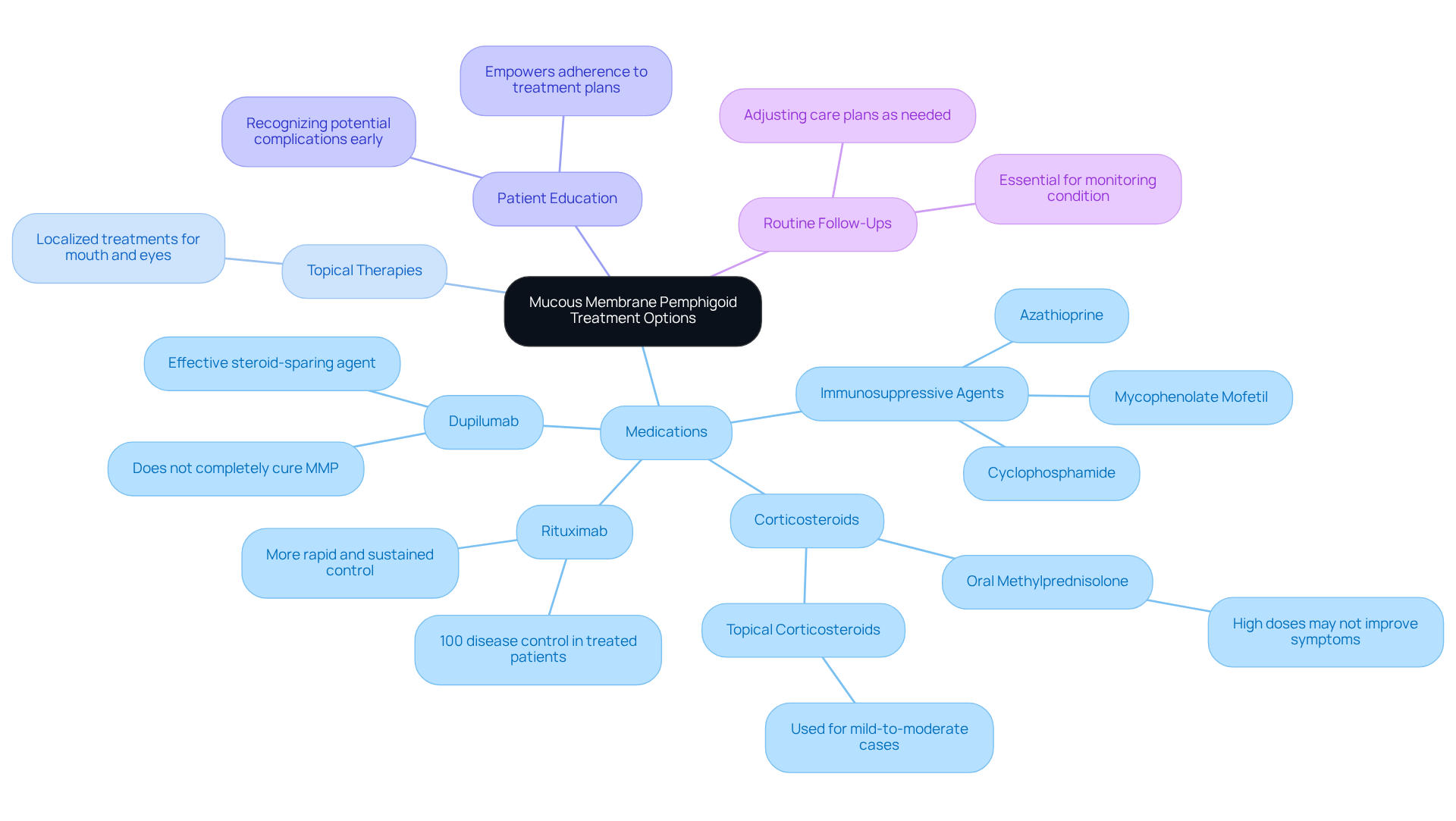
Conclusion
Mucous membrane pemphigoid (MMP) is a significant autoimmune condition that primarily affects mucous membranes, leading to distressing symptoms and potential complications. We understand that navigating this disorder can be challenging for both patients and healthcare providers. Early recognition and intervention are crucial, as they can drastically improve outcomes and enhance the quality of life for those affected.
This article highlights the multifaceted nature of MMP, covering its causes, symptoms, diagnostic methods, and treatment options. It is important to recognize risk factors such as age and gender and to understand the clinical features that signal MMP. A collaborative approach in diagnosis and treatment is essential. Effective management often requires a combination of therapies, including corticosteroids and immunosuppressants, alongside patient education and routine follow-ups to monitor progress.
Ultimately, raising awareness about mucous membrane pemphigoid is crucial for ensuring timely diagnosis and comprehensive care. By fostering a deeper understanding of this complex condition, individuals can be empowered to seek help and support, enhancing their journey toward better health. Engaging with patient organizations and healthcare professionals can provide valuable resources and a sense of community, reinforcing the importance of collective knowledge in navigating the challenges posed by MMP. We are here to help you through this process.
Frequently Asked Questions
What is mucous membrane pemphigoid (MMP)?
Mucous membrane pemphigoid (MMP) is a rare autoimmune blistering disorder that primarily affects mucous membranes, such as those in the eyes, mouth, and genitals, leading to the formation of blisters and erosions.
What are the potential complications of mucous membrane pemphigoid?
Significant complications of mucous membrane pemphigoid include severe ocular risks, such as scarring and potential vision loss if not managed effectively.
Who is most commonly affected by mucous membrane pemphigoid?
Mucous membrane pemphigoid primarily affects older individuals, with a peak occurrence around the age of 70, and is approximately twice as common in women compared to men.
What factors may increase the risk of developing mucous membrane pemphigoid?
Increased risk factors include a history of other immune system disorders, genetic factors such as family history of immune disorders, and environmental influences like exposure to certain medications or infections.
How is mucous membrane pemphigoid managed?
Management of mucous membrane pemphigoid involves a multidisciplinary approach, often requiring collaboration among specialists to ensure comprehensive care.
What role do patient organizations play in the management of mucous membrane pemphigoid?
Patient organizations provide vital resources and support, helping individuals connect with others facing similar challenges and fostering a sense of community.
Why is early diagnosis and intervention important for mucous membrane pemphigoid?
Early diagnosis and intervention are crucial because mucous membrane pemphigoid is often underrecognized due to its rarity, and timely management can improve patient outcomes and quality of life.






